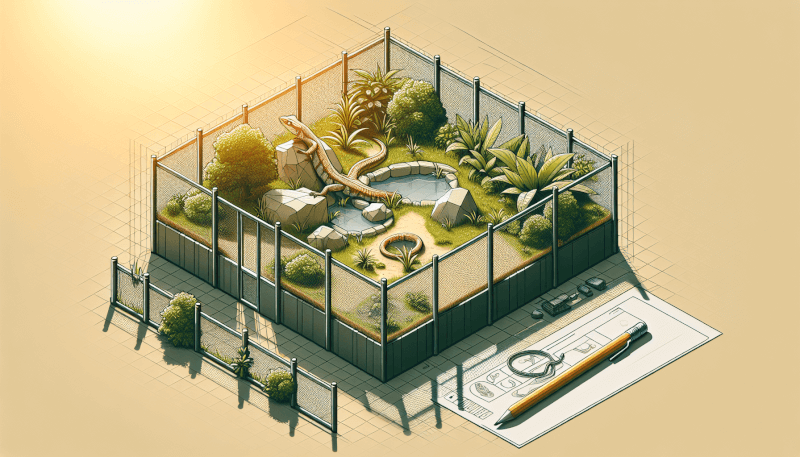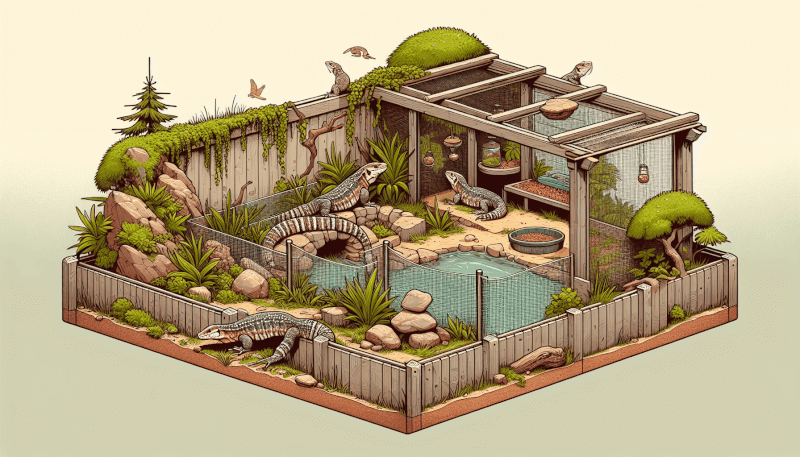Are you a reptile enthusiast looking to provide a safe and stimulating environment for your scaly companion? Look no further! In this article, we will guide you through the process of creating a secure outdoor enclosure that caters to the unique needs of your reptile. From selecting the appropriate materials to designing a habitat that mimics their natural habitat, we will cover all the essential steps to ensure your reptile’s safety and happiness in the great outdoors. So, grab your tools and get ready to embark on an exciting adventure of building the perfect outdoor haven for your reptile friend!
Selecting the Right Location
When planning to create an outdoor enclosure for your reptile, selecting the right location is crucial. Considerations such as climate, natural sunlight exposure, and proximity to noise or disturbances should be taken into account.
Climate Considerations
Different reptiles thrive in different climates. Research the specific temperature and humidity requirements of your reptile species to ensure that the climate of the chosen location aligns with their needs. Some reptiles may require warmer or cooler temperatures, so it’s essential to choose a location that can provide the necessary conditions.
Natural Sunlight Exposure
Natural sunlight exposure is crucial for reptiles as it allows them to engage in essential behaviors like basking and thermoregulation. When selecting a location, take into consideration the amount of direct sunlight the area receives throughout the day. Aim for a spot that offers a good balance of sunshine and shade to cater to your reptile’s needs.
Proximity to Noise or Disturbances
Reptiles are sensitive to noise and disturbances, which can cause them stress. Avoid placing the enclosure near loud traffic areas, construction sites, or other sources of constant noise. Choose a quiet location where your reptile can feel safe and secure.
Choosing the Right Materials
Selecting the right materials for your outdoor enclosure is essential to ensure durability, security, and the overall well-being of your reptile.
Durable and Secure Fencing
When it comes to fencing, opt for materials that are sturdy, escape-proof, and can withstand outdoor conditions. Reptiles can be surprisingly adept at finding ways to escape, so choose fencing that has no gaps or weak points. Make sure the height of the fence is appropriate for your reptile’s size, as some species are excellent climbers.
Escape-proof Coverings
In addition to secure fencing, consider adding escape-proof coverings to any openings in the enclosure. This is especially important for larger enclosures or those with mesh walls. A mesh screen with small enough openings to prevent escape is a great option to ensure the safety of your reptile.
Non-toxic Plants and Substrates
If you plan to include plants or substrates in your outdoor enclosure, make sure they are non-toxic to reptiles. Some plants may be harmful to your pet if ingested, so research the plant species thoroughly before incorporating them into the enclosure. Choose reptile-safe substrates that are easy to clean and maintain while promoting your reptile’s health.

Providing Adequate Space
Sufficient space is essential for your reptile to thrive and exhibit natural behaviors. When creating an outdoor enclosure, consider the following factors to ensure proper space provision.
Calculating Minimum Enclosure Size
Research the specific space requirements for your reptile species to determine the minimum enclosure size. This will vary depending on the species’ size, activity level, and natural habitat. A larger enclosure than the minimum requirement is always preferable, as it allows for more freedom of movement and enrichment opportunities.
Incorporating Vertical and Horizontal Spaces
Creating a multi-level enclosure with both vertical and horizontal spaces helps replicate a natural environment and provides additional room for your reptile to explore. Include climbing structures, branches, and platforms to create different levels within the enclosure. This will allow your reptile to exercise and fulfill its natural instincts.
Including Hiding Spots
Hiding spots are crucial for reptiles as they provide a sense of security and privacy. Incorporate various hiding spots such as caves, hollow logs, or plant coverings where your reptile can retreat when stressed or in need of rest. These hiding spots also aid in maintaining optimal temperature and humidity levels.
Ensuring Temperature Regulation
Temperature regulation is vital for reptiles, as they rely on external heat sources to maintain their body temperature. When constructing an outdoor enclosure, consider the following factors to ensure proper temperature regulation.
Placement of Thermoregulation Zones
Create temperature gradients within the enclosure to allow your reptile to move freely between warmer and cooler areas. Place heat sources such as basking lamps or heat mats in specific zones to provide a range of temperatures for your reptile to choose from. This will enable them to regulate their body temperature effectively.
Use of Heat Sources and Shade Structures
Incorporate heat sources like heat lamps or mats to provide the essential warmth your reptile needs. Additionally, ensure that the enclosure offers ample shade structures, such as natural vegetation or artificial coverings, to provide relief from excessive heat. This will allow your reptile to find the perfect balance and prevent any risk of overheating.
Monitoring and Adjusting Temperature
Regularly monitor the temperature within the enclosure to ensure that it stays within the appropriate range for your reptile species. Use a reliable thermometer or temperature probe to accurately measure the temperature at different locations. Adjust the positioning or intensity of heat sources as needed to maintain the ideal temperature gradient.

Maintaining Proper Humidity Levels
Humidity is crucial for many reptile species, as it helps them shed their skin properly and promotes overall health. When designing an outdoor enclosure, consider the following factors to ensure proper humidity levels.
Choosing the Right Substrate
Select a substrate that can help retain moisture and provide a suitable humidity level for your reptile’s needs. The substrate should be able to hold and slowly release moisture, ensuring a consistent and appropriate humidity level within the enclosure. Research the specific substrate requirements for your reptile species.
Utilizing Water Features
Water features such as shallow pools, misting systems, or drippers can help increase the humidity within the enclosure. Reptiles can drink from these water sources and also absorb moisture through their skin. Ensure that water sources are cleaned regularly to prevent the growth of harmful bacteria.
Misting and Humidifiers
Misting the enclosure with water can help temporarily increase humidity levels, especially in drier climates. Consider using a reptile-specific misting system or manually mist the enclosure at regular intervals. In cases where humidity maintenance proves challenging, a humidifier designed for reptile enclosures may be required.
Implementing Proper Ventilation
Proper ventilation is essential for maintaining air quality and preventing the buildup of stagnant air within the enclosure. Consider the following factors when designing an outdoor enclosure.
Optimizing Airflow within the Enclosure
Design the enclosure in a way that promotes natural airflow. Ensure that there are openings or vents across the enclosure to allow fresh air to circulate. This will help maintain proper oxygen levels and prevent the accumulation of any odors or harmful gases.
Preventing Condensation and Mold Growth
In outdoor enclosures, excessive humidity or poor ventilation can lead to condensation and mold growth. Monitor the enclosure regularly to ensure that there are no signs of excessive moisture buildup or mold. Proper airflow and humidity control will help prevent these issues.
Adding Ventilation Openings
Incorporate specific ventilation openings or small mesh panels to enable the free exchange of air. Place these openings strategically to avoid direct airflow on your reptile or any potential escape routes. Regularly clean and inspect these openings to ensure they are not blocked or obstructed.

Securing the Enclosure
Creating a secure enclosure is crucial to prevent escape and protect your reptile from potential predators or intruders. Consider the following measures to ensure the safety of your reptile.
Dig-proofing the Base
Some reptiles are skilled diggers and may attempt to escape by burrowing. To prevent this, use an appropriate base material that is resistant to digging. This can include concrete, buried wire mesh, or layers of sturdy substrate that make it difficult for reptiles to dig through.
Preventing Predators and Intruders
Install barriers or additional fencing around the enclosure to prevent predators or other animals from gaining access. This is especially important if you live in an area with potential threats such as raccoons, cats, or birds of prey. Ensure that the barriers are constructed with durable materials and extend both above and below ground to deter climbing or burrowing animals.
Locking or Securing Access Points
Make sure all access points to the enclosure, such as doors and windows, are securely locked or fastened. Use sturdy latches or locks that cannot be easily opened by curious or determined animals. Regularly inspect these access points to identify any signs of wear or damage that may compromise the security of the enclosure.
Selecting Suitable Décor and Furnishings
Creating a stimulating and enriching environment within the outdoor enclosure is crucial for the well-being of your reptile. Consider the following factors when choosing décor and furnishings.
Naturalistic Hides and Climbing Structures
Incorporate hides and climbing structures that mimic the natural habitat of your reptile. These can include rocks, branches, logs, or artificial structures. Providing a range of options will encourage natural behaviors such as climbing, exploring, and seeking shelter when needed.
Safe and Enriching Substrates
Choose substrates that are safe for your reptile and promote natural behaviors. Substrates such as soil, sand, bark, or reptile-specific bedding can provide opportunities for digging, burrowing, or foraging. Ensure that the substrates are regularly cleaned or replaced when necessary to maintain hygiene.
Water Bowls and Feeding Stations
Include water bowls and feeding stations within the enclosure to ensure that your reptile has easy access to fresh water and food. Provide shallow water dishes that are easy to clean and refill. Place feeding stations in areas where the reptile feels secure and can eat without any disturbances.

Maintaining a Clean and Sanitary Environment
Regular maintenance and cleaning of the outdoor enclosure are essential to ensure a clean and sanitary environment for your reptile. Consider the following procedures to maintain cleanliness.
Regular Spot Cleaning and Waste Removal
Perform regular spot cleaning by removing any feces, uneaten food, or soiled substrates. This will help prevent the buildup of waste, maintain hygiene, and reduce the risk of bacterial or fungal growth. Replace soiled substrates as needed to keep the enclosure clean and odor-free.
Disinfection and Decontamination Procedures
Periodically disinfect surfaces within the enclosure to eliminate any potential pathogens. Use reptile-safe disinfectants and follow the manufacturer’s instructions carefully. Pay special attention to high-touch areas and water features to prevent the growth of harmful bacteria.
Pest and Parasite Control Measures
Implement measures to prevent pests and parasites from infesting the enclosure. Regularly inspect the enclosure for any signs of pests such as mites, ticks, or flies. Use pest control methods that are safe for reptiles, such as natural repellents or targeted treatments. Consult with a reptile veterinarian if you suspect or encounter any pest or parasite-related issues.
Monitoring Health and Wellness
Constant vigilance and monitoring of your reptile’s health and well-being are paramount. Regularly observe and assess your reptile to ensure its continued health.
Regular Health Checks and Observations
Observe your reptile for any changes in behavior, appetite, or physical appearance. Regularly examine their skin, eyes, mouth, and limbs for any signs of injury, infection, or abnormalities. Monitor their weight and, if necessary, consult with a reptile veterinarian for routine check-ups.
Providing Proper Nutrition and Hydration
Ensure that your reptile’s dietary and hydration needs are met. Research the specific requirements for your reptile species and provide a balanced diet consisting of appropriate prey items, vegetables, fruits, and specialized reptile food. Ensure a constant supply of fresh water in a clean and easily accessible container.
Seeking Veterinary Care as Needed
If you notice any concerning signs or symptoms, or if your reptile’s health deteriorates, seek veterinary care promptly. Reptiles can hide illness well, so it’s crucial to be vigilant and address any health concerns in a timely manner. Regular veterinary visits are also essential for preventive care and to ensure the long-term well-being of your reptile.
Creating a safe and suitable outdoor enclosure for your reptile requires careful planning and attention to detail. By selecting the right location, materials, and furnishings, as well as maintaining appropriate temperature, humidity, and cleanliness, you can provide the optimal environment for your reptile to thrive. Regular monitoring of their health and well-being will help ensure a happy and healthy reptile companion for years to come.


